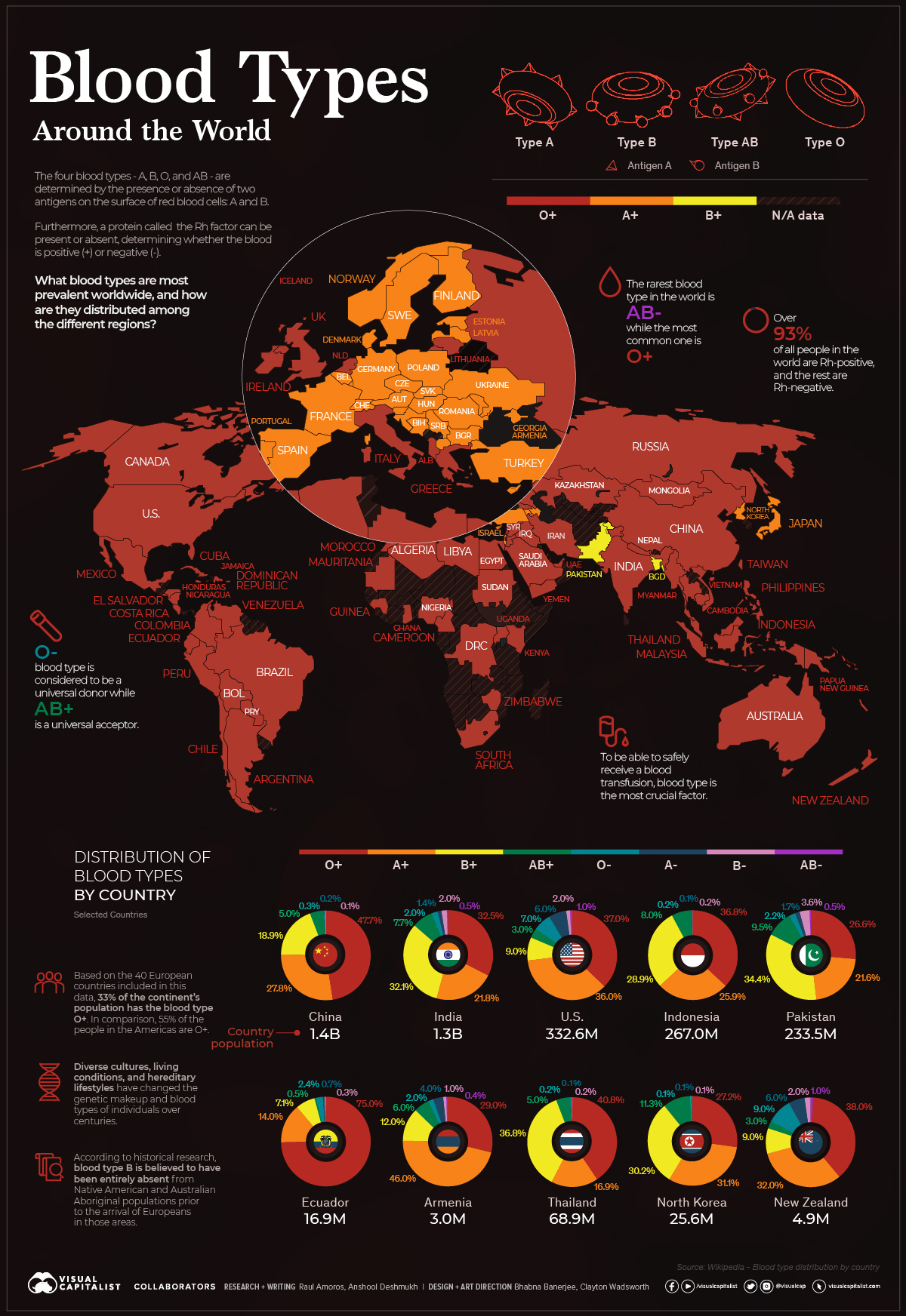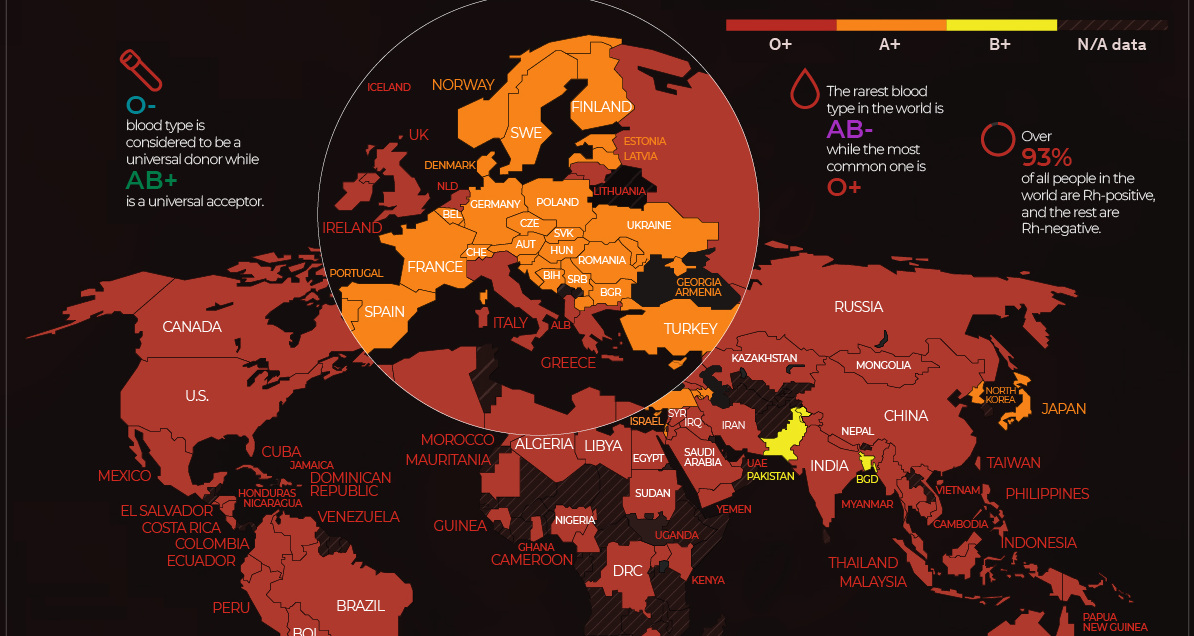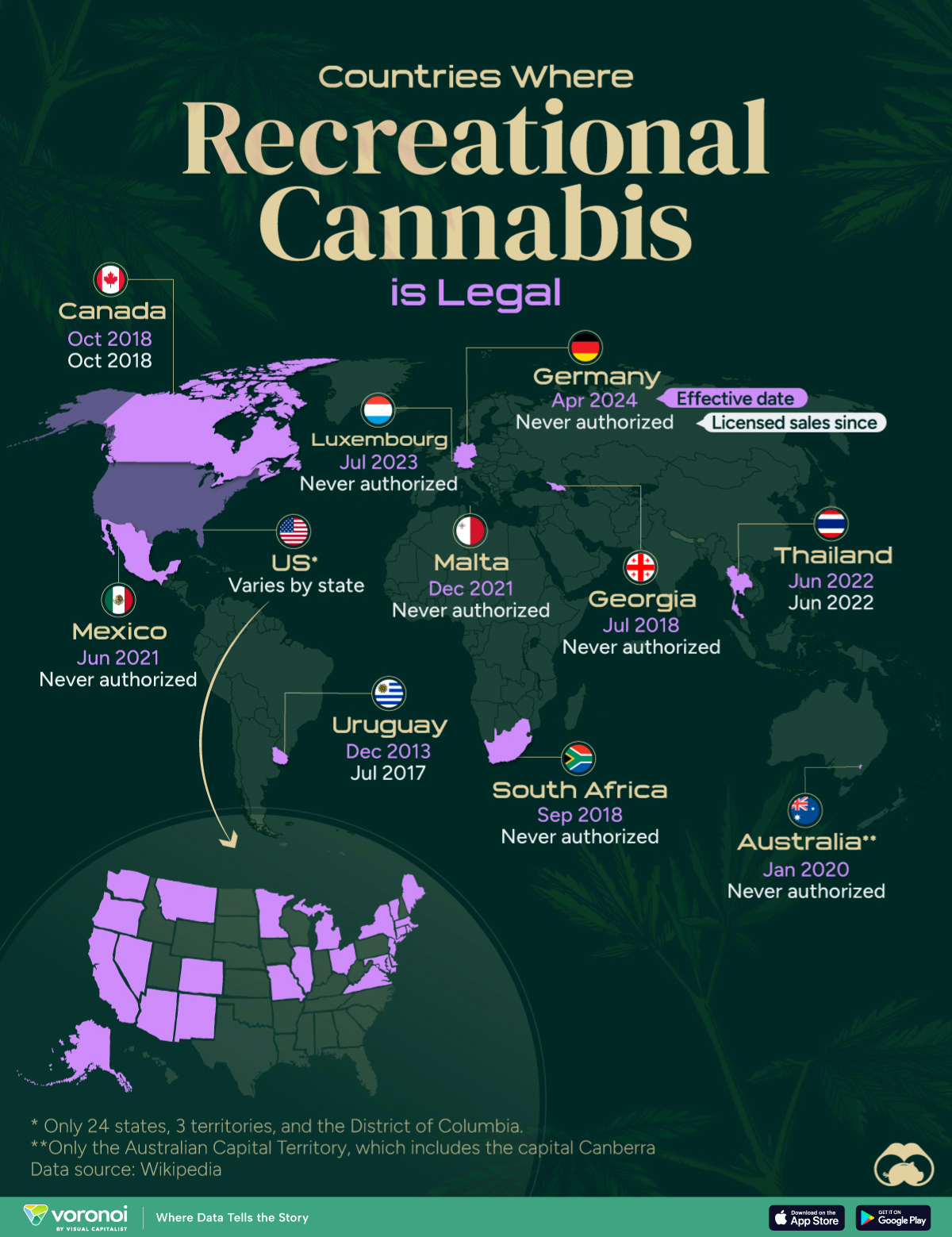Healthcare
Visualizing The Most Widespread Blood Types in Every Country
View the full-size infographic map
The Most Widespread Blood Types, by Country
Blood is essential to the human body’s functioning. It dispenses crucial nutrients throughout the body, exchanges oxygen and carbon dioxide, and carries our immune system’s “militia” of white blood cells and antibodies to stave off infections.
But not all blood is the same. The antigens in one’s blood determine their blood type classification: There are eight common blood type groups, and with different combinations of antigens and classifications, 36 human blood type groups in total.
Using data sourced from Wikipedia, we can map the most widespread blood types across the globe.
Overall Distribution of Blood Types
Of the 7.9 billion people living in the world, spread across 195 countries and 7 continents, the most common blood type is O+, with over 39% of the world’s population falling under this classification. The rarest, meanwhile, is AB-, with only 0.40% of the population having this particular blood type.
Breaking it down to the national level, these statistics begin to change. Since different genetic factors play a part in determining an individual’s blood type, every country and region tells a different story about its people.
Regional Distribution of Blood Types
Asia
Even though O+ remains the most common blood type here, blood type B is relatively common too. Nearly 20% of China’s population has this blood type, and it is also fairly common in India and other Central Asian countries.
Comparatively, in some West Asian countries like Armenia and Azerbaijan, the population with blood type A+ outweighs any others.
Americas
The O blood type is the most common globally and is carried by nearly 70% of South Americans. It is also the most common blood type in Canada and the United States.
Here is a breakdown of the most common blood types in the U.S. by race:
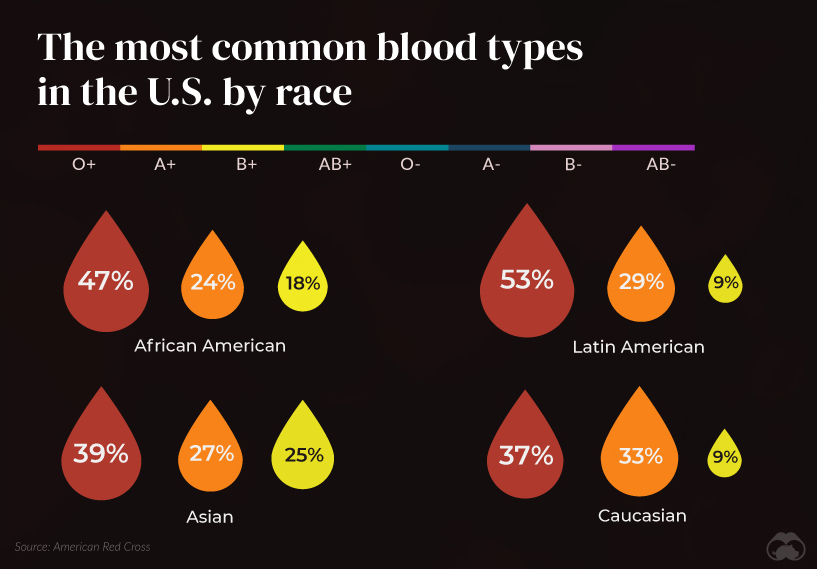
Africa
O+ is a strong blood group classification among African countries. Countries like Ghana, Libya, Congo and Egypt, have more individuals with O- blood types than AB+.
Europe
The A blood group is common in Europe. Nearly 40% of Denmark, Norway, Austria, and Ukraine have this blood type.
Oceania
O+ and A+ are dominant blood types in the Oceanic countries, with only Fiji having a substantial B+ blood type population.
Middle East
More than 41% of the population displays the O+ blood group type, with Lebanon being the only country with a strong O- and A- blood type population.
The Caribbean
Nearly half of people in Caribbean countries have the blood type O+, though Jamaica has B+ as the most common blood type group.
Here is the classification of the blood types by every region in the world:
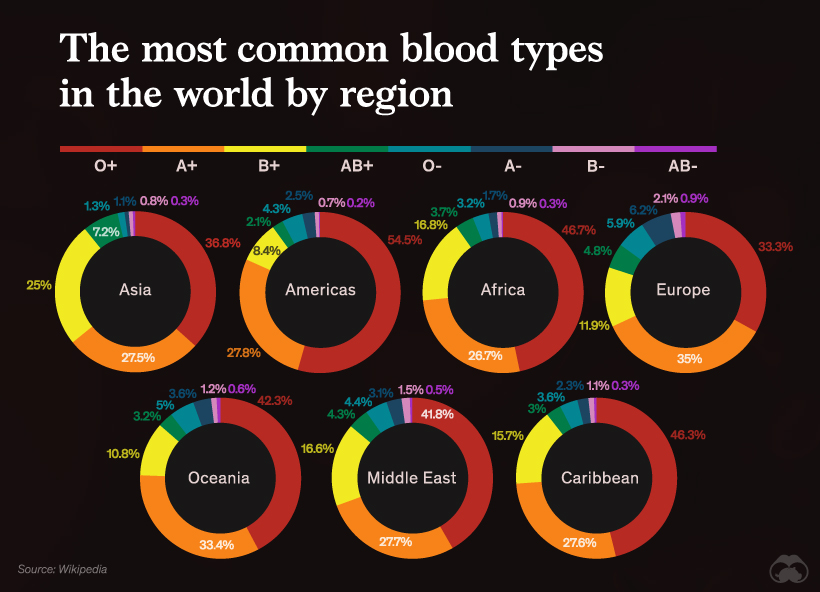
Unity in Diversity
Even though ethnicity and genetics play a vital role in determining a person’s blood type, we can see many different blood types distributed worldwide.
Blood provides an ideal opportunity for the study of human variation without cultural prejudice. It can be easily classified for many different genetically inherited blood typing systems.
Our individuality is a factor that helps determine our life, choices, and personalities. But at the end of the day, commonalities like blood are what bring us together.
United States
Mapped: Countries Where Recreational Cannabis is Legal
In total, only nine countries have fully legalized recreational cannabis use.
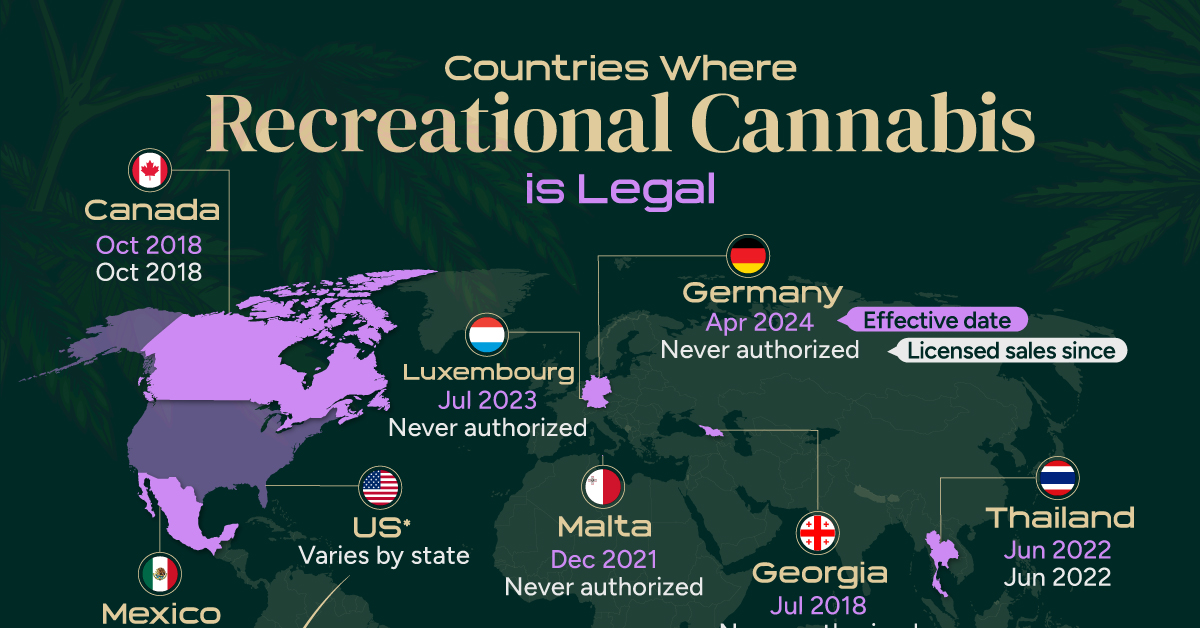
Countries Where Recreational Cannabis is Legal
This was originally posted on our Voronoi app. Download the app for free on iOS or Android and discover incredible data-driven charts from a variety of trusted sources.
In 2024, Germany became the third European Union country to legalize cannabis for personal use, following Malta and Luxembourg.
Here, we map the countries where recreational cannabis use is allowed as of April 2024, based on data from Wikipedia.
Limited to Few Countries
In total, only nine countries have legalized recreational cannabis use nationwide. However, just a few of them have licensed sales.
| Country | Effective date | Licensed sales since |
|---|---|---|
| 🇺🇾 Uruguay | December 2013 | July 2017 |
| 🇬🇪 Georgia | 30 July 2018 | Never authorized |
| 🇿🇦 South Africa | 18 September 2018 | Never authorized |
| 🇨🇦 Canada | 17 October 2018 | 17 October 2018 |
| 🇲🇽 Mexico | 28 June 2021 | Never authorized |
| 🇲🇹 Malta | 14 December 2021 | Never authorized |
| 🇹🇭 Thailand | 9 June 2022 | 9 June 2022 |
| 🇱🇺 Luxembourg | 21 July 2023 | Never authorized |
| 🇩🇪 Germany | 1 April 2024 | Never authorized |
| 🇺🇸 U.S. | Varies by state | Varies by state |
| 🇦🇺 Australia | Varies by jurisdiction | Never authorized |
At the federal level, cannabis is still considered an illegal substance in the United States. That said, individual states do have the right to determine their laws around cannabis sales and usage. Currently, cannabis is allowed in 24 states, 3 territories, and the District of Columbia.
Interestingly, the oldest legal text concerning cannabis dates back to the 1600s—when the colony of Virginia required every farm to grow and produce hemp.
Since then, cannabis use was fairly widespread until the 1930s when the Marihuana Tax Act was enforced, prohibiting marijuana federally but still technically allowing for medical use.
Today, the U.S. cannabis market is a $30 billion business. By the end of the decade, that number is expected to be anywhere from $58 billion to as much as $72 billion.
Similar to the U.S., Australia does not allow the use at the national level, but cannabis can be used legally in the Australian Capital Territory, which includes the capital Canberra.
-

 Maps7 days ago
Maps7 days agoMapped: Southeast Asia’s GDP Per Capita, by Country
-

 Markets2 weeks ago
Markets2 weeks agoVisualizing Global Inflation Forecasts (2024-2026)
-

 United States2 weeks ago
United States2 weeks agoCharted: What Southeast Asia Thinks About China & the U.S.
-

 United States2 weeks ago
United States2 weeks agoThe Evolution of U.S. Beer Logos
-

 Healthcare1 week ago
Healthcare1 week agoWhat Causes Preventable Child Deaths?
-

 Energy1 week ago
Energy1 week agoWho’s Building the Most Solar Energy?
-

 Markets1 week ago
Markets1 week agoMapped: The Most Valuable Company in Each Southeast Asian Country
-

 Technology1 week ago
Technology1 week agoMapped: The Number of AI Startups By Country

